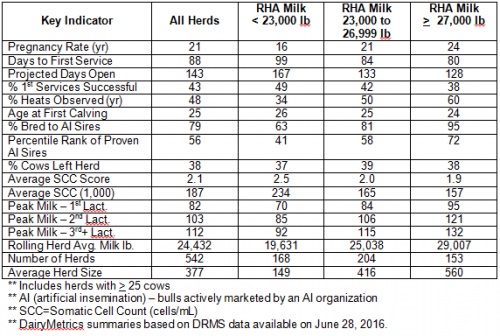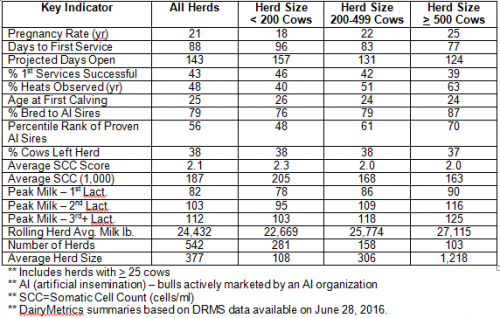Performance indicators for Michigan dairy herds
These performance indicators can be used to benchmark production, reproduction, genetics and udder health status in your dairy herd.
When monitoring herd performance, dairy herd managers and their consultants may wonder how the herd compares to other dairy herds in the state and elsewhere. A comparison to herds managed similarly can be useful when developing performance goals. Information from Michigan dairy herds enrolled in the Dairy Herd Information Association (DHIA) program was summarized based on two management characteristics: production and herd size.
The DairyMetrics program available from Dairy Records Management Services (DRMS) was used to evaluate performance data for Michigan DHIA dairy herds. For Table 1, herds were divided into three groups based on rolling herd average for milk (< 23,000 lb, 23,000 - 26,999 lb, and > 27,000 lb). The herds are grouped by herd size in Table 2 (< 200 cows, 200 – 499 cows, and > 500 cows). Data in both tables are from the DHI-202 Herd Summary report of each herd’s most recent test day as of June 28, 2016. Information presented in each table includes averages for several key indicators of overall herd management.
Trends - Production groups
Several general trends were observed across the production groupings.
- The highest production group has the highest average pregnancy rate (24 percent) and the lowest average days open (80 days). To achieve this level of reproductive performance, these higher producing herds also have the lowest average days to first service and the highest average percentage of heats observed.
- The highest production group has the lowest average somatic cell count (153,000 cells/mL).
- An impressively high percentage of AI (artificial insemination) sires (95 percent) are used by the highest production group. These herds also have a higher percentile ranking for genetic merit (Net Merit $).
- Average herd size is the largest for the highest production group.
These trends should not be considered a cause-and-effect relationship between milk production and the other key indicators. More likely management factors that positively influence milk production also have a positive impact on other aspects of herd performance.
Table 1. Averages of Michigan DHI herds by rolling herd average milk levels
Trends - Herd size groups
The most notable trends across the groupings based on herd size are:
- The larger herds tend to have more desirable reproductive performance. Pregnancy rate averages ranged from 25 percent in the largest herds to 18 percent in the smallest herds.
- The average days open was lowest in the largest herd category. The largest herd category also had the highest percentage heats observed and lowest days to first service. However, the highest percentage of successful first services was in the lowest herd size category.
- Average somatic cell count was lowest in the middle and large herd size categories.
- The larger herds tended to have higher rolling herd averages for milk yield, a trend that has existed for a number of years. It should be noted that a significant range in production exists in each herd size category. In fact, the highest producing herd in each size category had a rolling herd average for milk above 33,000 lb.
The items in both tables are indicators of herd performance only. Other business management criteria would be considered when evaluating the financial status of the herd.
Table 2. Averages of Michigan DHI herds by herd size levels
Using DairyMetrics
DairyMetrics is a benchmarking tool for dairy farm performance evaluation. Herd managers and their herd consultants can compare their own herds to a group of DHIA herds that meet their selected criteria (cohort herds). The cohorts can be chosen based on parameters within five categories (general, production, udder health, reproduction and genetic information). Herds from other states that are processed by DRMS also can be included in comparisons.
More information about the DairyMetrics program is available from DRMS or your DHIA service affiliate.



 Print
Print Email
Email




